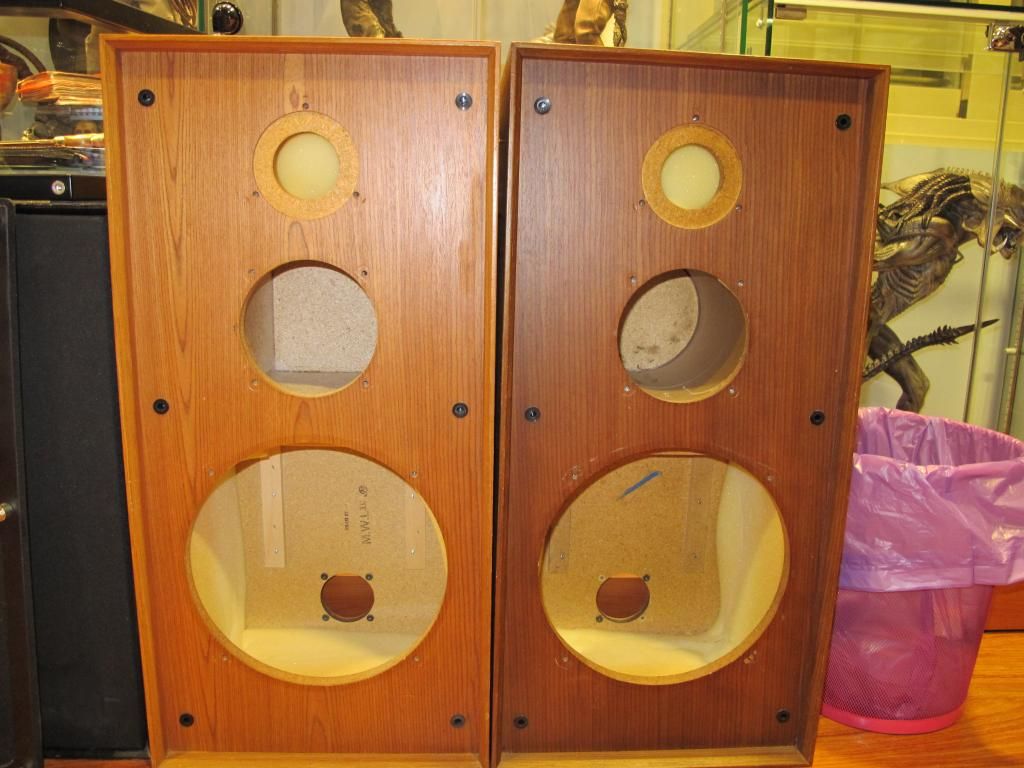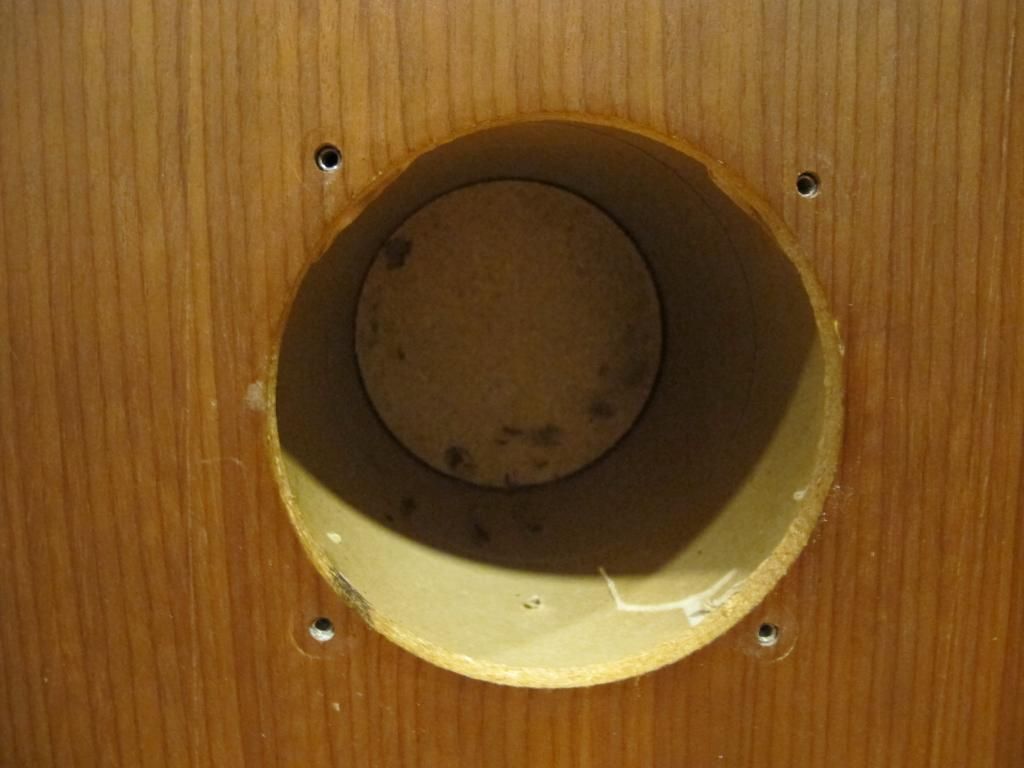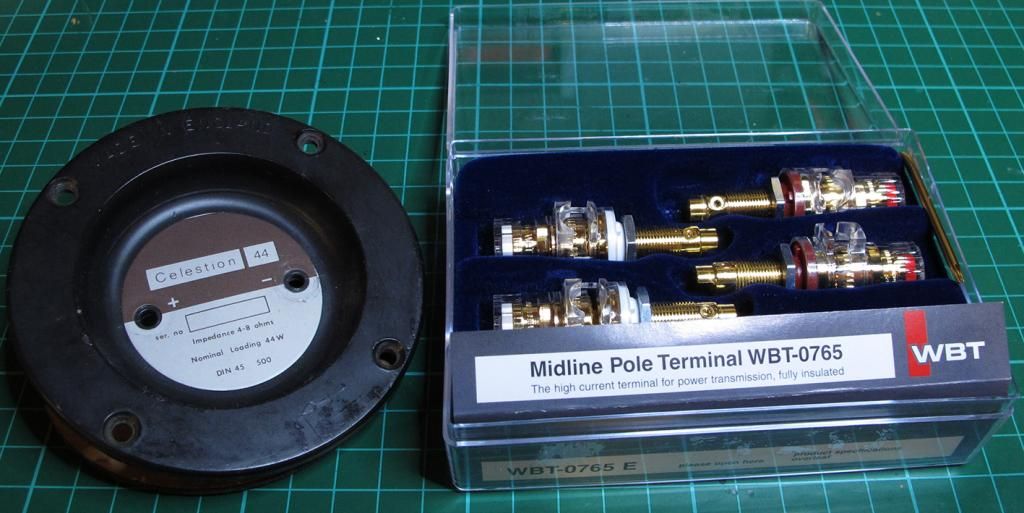Greetings Gentlemen
I allready have a working pair of Celestion Ditton 44 that sounds wonderfull, but allways wondered If they would sound better with modern components. Don't want to spoil my pair in this experiment, so a few days ago purchased and extra pair in aceptable shape, and I'm planing to restore the exterior, and upgrade the capacitors, coils and wires of the filter, to see if I get a better sound that the ones I allready have.
Sadly, I'ts my first project and will need some help if you please. Don't know what componets brands to get, what audio wire to use, What maintenance I could do with the cones/tweeters 😱 so i will need answers for many questions 😉 thanks in advance Guys.
I allready have a working pair of Celestion Ditton 44 that sounds wonderfull, but allways wondered If they would sound better with modern components. Don't want to spoil my pair in this experiment, so a few days ago purchased and extra pair in aceptable shape, and I'm planing to restore the exterior, and upgrade the capacitors, coils and wires of the filter, to see if I get a better sound that the ones I allready have.
Sadly, I'ts my first project and will need some help if you please. Don't know what componets brands to get, what audio wire to use, What maintenance I could do with the cones/tweeters 😱 so i will need answers for many questions 😉 thanks in advance Guys.
Heck of a project you are taking on there, my friend. 😱
I have a pair myself, but upgrading them would be hugely expensive.
One of the awkward aspects is the mid is the quite large and non-standard size around 150mm. So hard to upgrade without a new baffle and box.
You'd be building a new speaker really. I'd really be more interested in a modern design like this one:
3-Way Classic
Having picked them up for £60, I find it hard to justify spending maybe £500 on components, never mind a toolkit, getting them up to scratch. They are a decent and revealing speaker which goes impressively loud, but maybe a bit bright and harsh at the top end.
Certainly a huge project which will be very difficult for the inexperienced. I don't know why we get so sentimental about 40 year old speakers.
I have a pair myself, but upgrading them would be hugely expensive.
An externally hosted image should be here but it was not working when we last tested it.
One of the awkward aspects is the mid is the quite large and non-standard size around 150mm. So hard to upgrade without a new baffle and box.
You'd be building a new speaker really. I'd really be more interested in a modern design like this one:
3-Way Classic
Having picked them up for £60, I find it hard to justify spending maybe £500 on components, never mind a toolkit, getting them up to scratch. They are a decent and revealing speaker which goes impressively loud, but maybe a bit bright and harsh at the top end.
Certainly a huge project which will be very difficult for the inexperienced. I don't know why we get so sentimental about 40 year old speakers.
Attachments
So here we go 😀
First I have done, is to disassemble the speakers, extract the tweeters and drivers, and also extract the filters.
Here are some pics:

as you can see these two unit's don't belong to the same pair, I bought them
"as it". The surpirse here is that the midrange driver compartment is different. In one unit is a cubic compartment that is not touching the rear panel (made of wood), in the other is a cilindric compartment, that touches the rear panel, and made of hard paper.
please check pics:


Midrange drivers, are visually identical. The "cilinder" one is measuring 4.8 ohms, and it gots "JH 11" printed in its metal frame. The "cube" one is measuring 5.2 ohms and it gotd "JH 23" printed in its metal frame.
So guys I'm a little confused here. They are the same driver model? Is the difference of 0.4 ohms between them a concern? Should I work on the boxes to make them the same? If thats the case, should I choose"cube" or "cilinder"?
This is really weird, and I still haven't touched the filters 🙁
Any comments and advices wellcome.
Thanks guys.
First I have done, is to disassemble the speakers, extract the tweeters and drivers, and also extract the filters.
Here are some pics:

as you can see these two unit's don't belong to the same pair, I bought them
"as it". The surpirse here is that the midrange driver compartment is different. In one unit is a cubic compartment that is not touching the rear panel (made of wood), in the other is a cilindric compartment, that touches the rear panel, and made of hard paper.
please check pics:


Midrange drivers, are visually identical. The "cilinder" one is measuring 4.8 ohms, and it gots "JH 11" printed in its metal frame. The "cube" one is measuring 5.2 ohms and it gotd "JH 23" printed in its metal frame.
So guys I'm a little confused here. They are the same driver model? Is the difference of 0.4 ohms between them a concern? Should I work on the boxes to make them the same? If thats the case, should I choose"cube" or "cilinder"?
This is really weird, and I still haven't touched the filters 🙁
Any comments and advices wellcome.
Thanks guys.
Thanks for your reply system, as a new user I'm being filtered by moderators, so can't reply fast. I have read some other interesting threads in this forum, will try to get info from there too.
About my upgrading, I plan to keep the original tweeters and drivers, and restore the exterior, will try to get modern polypropilene capacitors and, possibly, air core coils for the filters, and rewire them and the internal conections with some quality wire, but thats all.
Changing the drivers would be, as you say, making a new Speaker, and I love the sound of my working pair od 44's. Have tested many brands of expensive modern speakers, and none sounded like these. I guess I have my ears accustomed to their sound 🙂
About my upgrading, I plan to keep the original tweeters and drivers, and restore the exterior, will try to get modern polypropilene capacitors and, possibly, air core coils for the filters, and rewire them and the internal conections with some quality wire, but thats all.
Changing the drivers would be, as you say, making a new Speaker, and I love the sound of my working pair od 44's. Have tested many brands of expensive modern speakers, and none sounded like these. I guess I have my ears accustomed to their sound 🙂
It's funny you mention the differing midrange enclosures. I have that too! 😀
One aspect I don't like is the horrible rear speaker screw-on connectors. I'd rather have a modern banana socket.
Upgrading the wiring sounds good. New light speaker cable will have fresh copper. This sort of speaker will have used leaded solder, and the modern safer unleaded stuff needs higher temperatures so you'll need to work fast.
I think new BAF wadding could be a good investment too. It's actually used in air conditioning filters, and can be bought quite cheaply at the electrical wholesaler. I always try and leave some ventilation around the crossover too.
Crossover mods are not totally straightforward. Replacing non-polar caps with film types make a speaker brighter. Often you need to add a little resistance to compensate. I would think the mid particularly would benefit from better air coils. But again resistance might be significant.
One aspect I don't like is the horrible rear speaker screw-on connectors. I'd rather have a modern banana socket.
Upgrading the wiring sounds good. New light speaker cable will have fresh copper. This sort of speaker will have used leaded solder, and the modern safer unleaded stuff needs higher temperatures so you'll need to work fast.
I think new BAF wadding could be a good investment too. It's actually used in air conditioning filters, and can be bought quite cheaply at the electrical wholesaler. I always try and leave some ventilation around the crossover too.
Crossover mods are not totally straightforward. Replacing non-polar caps with film types make a speaker brighter. Often you need to add a little resistance to compensate. I would think the mid particularly would benefit from better air coils. But again resistance might be significant.
Nice, so your units are also different. Did you get them separately, or they were a pair originally? really weird this change of inner construction, would love to know which one is the original, and what is the upgrade.
BTW could someone please tell me, if the ohm values of my drivers are ok, or they should be replaced?
HF2000 Tweeters: one is reading 4.2ohm (this is the standard value) the other is reading 4.8ohm <- does this mean that is damaged and should be replaced, or its ok?
Same questions for the mid range drivers. one is reading 4.8ohm (i think this is the standard here) nut the other is reading 5.2ohm, same question, this altered value does mean that the driver is "touched" and should be replaced or it's still ok?
Many thanks guys.
BTW could someone please tell me, if the ohm values of my drivers are ok, or they should be replaced?
HF2000 Tweeters: one is reading 4.2ohm (this is the standard value) the other is reading 4.8ohm <- does this mean that is damaged and should be replaced, or its ok?
Same questions for the mid range drivers. one is reading 4.8ohm (i think this is the standard here) nut the other is reading 5.2ohm, same question, this altered value does mean that the driver is "touched" and should be replaced or it's still ok?
Many thanks guys.
AFAIK, they were a matched pair, so it was surprising there was a difference in construction. I had some chipboard cut to make a matching midrange box on the tubed speaker, but then wondered why I should care! 😀
Similarly, I wouldn't lose any sleep over a slightly different impedance on two drivers. Hardly audible, I'd think.
Mostly, when you disassemble old speakers, it's like giving them a service. You notice poor connections and loose joints and bolts in the cabinets and missing foam damping. I found the basses had been inadvertently wired out of phase. This was obvious when a placed the speakers close together and facing each other, and noticed the bass just about disappeared.
Worst of all, the cable connecting the cone to the chassis is very badly frayed on one bass, and likely to break soon. On the other hand, these sort of speaker used very substantial cast chassis. That is rare nowadays, as is three way closed box construction in general.
I suppose, as someone who likes trying things out, I wanted to remind myself what is special about three-ways. And they are special. Better than two ways IMO.
Similarly, I wouldn't lose any sleep over a slightly different impedance on two drivers. Hardly audible, I'd think.
Mostly, when you disassemble old speakers, it's like giving them a service. You notice poor connections and loose joints and bolts in the cabinets and missing foam damping. I found the basses had been inadvertently wired out of phase. This was obvious when a placed the speakers close together and facing each other, and noticed the bass just about disappeared.
Worst of all, the cable connecting the cone to the chassis is very badly frayed on one bass, and likely to break soon. On the other hand, these sort of speaker used very substantial cast chassis. That is rare nowadays, as is three way closed box construction in general.
I suppose, as someone who likes trying things out, I wanted to remind myself what is special about three-ways. And they are special. Better than two ways IMO.
About the topic you commented earlier. I have got some decent connectors for the speakers. Instalation is easy, you just need to dig new suitable holes in the back plastic pannel:

Also have disassembled one of the filters, extracted some capacitors, but can't identify the type, maybe someone could help please?

1 - Seems to be a bipolar capacitor, unknown dielectric material. Markings are "ELCAP - 72uF -50v - N.P" I think "NP" stands for "non polarised" but would love if anyone could confirm.
2 - Im a bit lost with this one. Also seems a bipolar type, but the band in one of the sides keeps me concerned it may be a polar one. Also unknewn dielectric. Markings are "ERIE A304 METALLISED 2.0uF 150V DC WKG 74/46"
3 - These ones seems a traditional electrolithic capacitor, but apart from the band no other sign is showing me polarity, all electrolithics I have seen had a minus marking on the cathode. need confirmation on this subject please. Markings are "24uF 25VDC RED WE 99RAS 8 75 8" the red one got "CCL 6uF 50v REV WG 75 CRAS MAR 73"

Also have disassembled one of the filters, extracted some capacitors, but can't identify the type, maybe someone could help please?

1 - Seems to be a bipolar capacitor, unknown dielectric material. Markings are "ELCAP - 72uF -50v - N.P" I think "NP" stands for "non polarised" but would love if anyone could confirm.
2 - Im a bit lost with this one. Also seems a bipolar type, but the band in one of the sides keeps me concerned it may be a polar one. Also unknewn dielectric. Markings are "ERIE A304 METALLISED 2.0uF 150V DC WKG 74/46"
3 - These ones seems a traditional electrolithic capacitor, but apart from the band no other sign is showing me polarity, all electrolithics I have seen had a minus marking on the cathode. need confirmation on this subject please. Markings are "24uF 25VDC RED WE 99RAS 8 75 8" the red one got "CCL 6uF 50v REV WG 75 CRAS MAR 73"
- Status
- Not open for further replies.
- Home
- Loudspeakers
- Multi-Way
- My First Project: Restoring and modernising a Pair of Celestion Ditton 44
